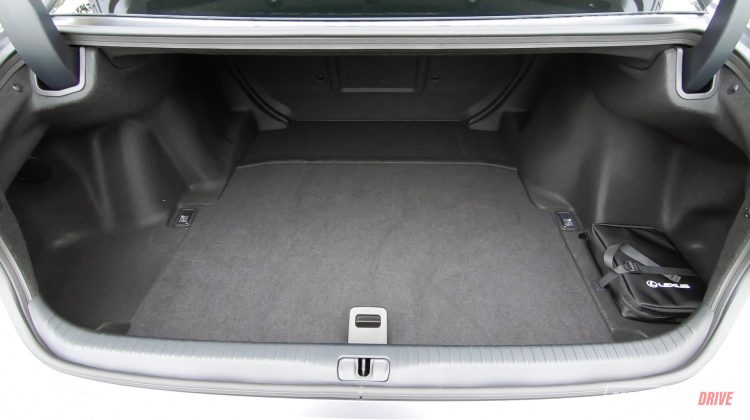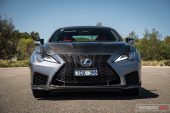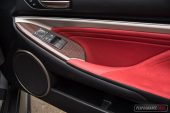How do you make a sports car even sportier? Simple. Just add carbon fibre. That’s what Lexus has done with its jack-hammering RC F Track Edition V8 coupe. It could be regarded as the Japanese brand’s most hardcore road car since the V10 LF-A.
The RC F Track Edition has its target sight set on rivals like the Audi RS 5 coupe, the outgoing BMW M4 CS, and the Mercedes-AMG C 63 S coupe. It’s based on the 2019-2020 RC F update which includes a number of under-the-skin revisions, however, thanks to a range of carbon fibre and even titanium parts the Track Edition is around 65kg lighter than the regular model.
Carbon fibre is an expensive material to produce and so, as no surprise, the Track Edition is an expensive vehicle. Prices start from $165,482, up from the $134,129 starting price of the regular 2020 RC F (excluding on-road costs).
2020 Lexus RC F Track Edition – THE SPECS
[column width=”47%” padding=”6%”]Engine: 5.0-litre V8
Output: 351kW@7100rpm / 530Nm@4800-5600rpm
Transmission: Eight-speed auto
Drive type: Rear-wheel drive, limited-slip diff
Wheels: F: 19×9.0, 255/35 R: 19×10, 275/35
ANCAP: Not tested
Kerb weight: 1715kg
Power-to-weight: 4.9:1 (kg:kW)
Official fuel economy: 11.2L/100km
Economy during test: 12L/100km
Fuel capacity/Type: 66L/98 RON[/column] [column width=”47%” padding=”0″]Power efficiency: 31.33kW:L/100km
0-60km/h: 2.70 seconds*
0-100km/h: 5.09 seconds*
0-200km/h: 17.18 seconds*
60-110km/h: 3.26 seconds*
1/4 mile: 13.48 seconds at 177.7km/h*
Max acceleration: 0.992g
100-0km/h braking: 2.80 seconds at 35.41 metres*
Max deceleration: -1.269g
Decibel at idle: 60*
Peak decibel at 60-100km/h: 91*
Priced from: $165,482[/column][end_columns]
* Figures as tested by PerformanceDrive on the day. Factory claims may be different
2020 Lexus RC F Track Edition – THE PACKAGE
Lexus vehicles always feel really solid and well-made. And the RC F is no different. Putting aside the eye-singeing red decor applied to the Track Edition’s interior, all of the fixtures and fittings have zero-tolerance in movement, with no squeaks or rattles to report. Some parts are carried over from Toyota vehicles, such as the old cruise control stalk, but all in all it is undoubtedly a high-quality luxury vehicle that’s garnished with obvious sporting flair.
Red leather and Alcantara decorate the lovely bucket seats in the front as well as sections of the centre console, instrument binnacle, and door trims. There’s also lush red carpet for sections of the floor, along with special red carbon fibre trim for the doors and dash to really set the scene. It’s not going to be to everyone’s taste but being a special edition we think there does need to be a degree of drama and a heighten sense of occasion in here. This colour scheme certainly succeeds in doing that.
The driving position is perfect. There’s no other way to describe it. The high-mounted dash and centre console provide that intimately submerged setting, while the electric-adjustable steering column points right at your chest, with natural pedal placement down below. Left-foot braking seems like it was a considering factor in the initial design plans as you don’t need to twist your body to do it, but in saying that, conventional right-footed driving is also accommodated for.
You might not be expecting much room in the back, being a four-seat coupe. Except, when you jump in you’ll find there is a surprising amount of room. We like that Lexus hasn’t bothered trying to squeeze in a middle seat, and it’s encouraging to see climate vents in the back of the console. Instead of a middle seat there is, what feels like, a low-rent plastic dish that seems like it was designed without much thought. There is no flip-down arm rest either, and no cup holders. Maybe we’re being a bit ambitious with this but headroom and legroom are both respectable and some adults could enjoy a decent-length drive back here (so long as they are shorter than around 175cm), so why not fit such amenities?
In-car entertainment is provided by a 10.3-inch wide-screen media interface, positioned atop the dash. This is new for the 2019-2020 facelift. Unfortunately, Android Auto and Apple CarPlay are not included but you do get digital radio, Bluetooth, sat-nav with live SUNA traffic updates, Miracast, and a powerful 17-speaker Mark Levinson sound system. The sound quality is awesome, especially if you tinker around with the equaliser settings to find your preferences.
Lexus continues pressing on with its ‘Remote Touch’ pad system which you use to navigate your way around the screen (no touch-screen capability). This is a shame we think as it is very fiddly and requires a lot of your attention to operate. Clever and very advanced, yes. But paired with the action of driving it’s about as distracting as checking your Facebook feed on your phone. There are various settings to play around with, which really helps. For instance you can control the level of force feedback from the pad, turn on/off auto screen change, and even change around the cursor/pointer speed.
Boot space is rated at 366 litres, although it actually looks bigger than that in person. The width and horizontal depth seems almost as capacious as a medium sedan. There’s a tyre repair kit under the boot floor and some tie hooks for added convenience.
2020 Lexus RC F Track Edition – THE DRIVE
Let’s kick off by mentioning some of the highlight mechanical updates for both the 2019-2020 facelift and those specific to the Track Edition. Some of the changes are pretty serious while others seem like measures applied purely to lift the wow factor and overall excitement of the car.
Firstly, a full carbon fibre bonnet, front spoiler, roof, massive rear wing (generates 26kg of downforce), and rear diffuser have been crafted for the Track Edition. A titanium exhaust is also part of the package, complete with blue-tinted tips, saving 6kg. There’s also a set of BBS lightweight wheels that hide hardcore carbon ceramic brakes, both of which alleviate 25kg in unsprung mass. All up, about 65kg is saved compared with the regular RC F.
The regular RC F (as well as the Track Edition) is also administered with some aluminium suspension components, swapped from the previously used steel arrangements. Hollow rear axle shafts made from aluminium, for example, are stronger and lighter (by 1.8kg), while the outer casings of the ZF front suspension upper supports are now made from aluminium (saving 0.7kg).
As you can see Lexus has developed some fairly drastic measures to help increase the fanatical attention to detail showcased with the RC F. Lexus says engineers extensively tuned the complete setup so that, thanks to various driving modes, the car is suited to a wide range of conditions, too. In fact, the company says the Normal mode is ideal for tracks like the Nurburgring, while the Sport S+ mode is best-suited to circuits like Fuji Speedway.
Around corners we think the RC F has always felt very solid and sure-footed, gliding around like it’s on rails. The steering is nicely weighted and there is enough feedback when you start to wrestle with it and play around. Just plodding about, the steering feel takes a backseat while you enjoy a soothing and calm drive, with that V8 burbling away up front. During heated driving the RC F can almost feel overly planted and heavy, but if you keep pushing it, hard, you’ll find that solidity reassuring and confidence-boosting.
Also helping to lift your confidence levels are the carbon ceramic brakes. These provide incredible resistance to fade, with full braking power seemingly always available, no matter how much you abuse them. We notice the brake disc hubs are made in Germany while the calipers are by Brembo of Italy. According to our tests the emergency stop from 100-0km/h takes just 35.41 metres. That’s around a metre shorter than what we’ve tested in the regular RC F models in the past. However, that’s not the full story. These provide more consistent performance during repeated heavy use as well.
It might not feature some high-tech dual-stage turbocharger or electric motor ‘boost’ mechanism, but this motor is still a masterpiece. We think it’s more of an achievement than some of the rival engines precisely because it doesn’t get any help from such systems. This is a raw, naturally aspirated unit that relies on capacity, a high compression ratio of 12.3:1, twin overhead cams running variable valve timing, and direct and port injection to produce its goods.
Lexus has been building the ‘2UR’ 5.0-litre unit for over 10 years now, ever since it debuted in our old friend the Lexus IS F in 2007. A number of advancements have been applied to it over the years, including a raised compression ratio and the implementation of D-4S dual injection. It still uses Yamaha-developed heads and titanium valves, but for the 2019-2020 update Lexus engineers have modified the dual intake runners. Instead of opening at 3600rpm, the secondary intake now opens at 2800rpm for improved low-end response (and more of that glorious induction noise).
There’s no more power or torque for this latest update though. The V8 continues to produce 351kW at 7100rpm – the same as the 2UR update that was introduced with the RC F and GS F in 2014 and 2016 – while peak torque remains at 530Nm, available between 4800rpm and 5600rpm. Just looking at these figures on paper you can see this is a progressive and peaky engine. Those jumping straight from one of the forced-induction rivals will notice a lack of low-end grunt in comparison, but make no mistake, there is plenty of top-end thrust and an awesome soundtrack to be enjoyed from this engine.
During our usual performance tests on a private road, with a Racelogic Vbox Sport, we clocked a best 0-100km/h in 5.09 seconds, and the quarter mile in 13.48 seconds – Lexus claims 0-100km/h comes up in 4.3 seconds. We also timed 0-200km/h in a dashing 17.18 seconds.
Behind the engine is a Toyota-Aisin ‘AA80E’ eight-speed automatic transmission. Shift behaviour isn’t quite as snappy as a dual-clutch auto, and perhaps slightly less refined than the widely-used ZF 8HP eight-speed auto during sporty driving. However, this unit is brilliantly versatile. Being a Lexus (literally meaning Luxury EXport to USa) the RC F, even in Track Edition guise, still has to live up to the company’s renowned luxury reputation. And that’s what this gearbox helps with.
It is very smooth and comfortable when you just want to cruise around but also offers spirited shifts, complete with an exhilarating exhaust pop when you turn up the tempo. The ride quality is also very adaptable, suiting committed track stints in Sport mode, but also providing good absorption and comfort levels in the normal mode.
2020 Lexus RC F Track Edition – THE VIDEOS
2020 Lexus RC F Track Edition – THE VERDICT
This is likely one of the last of a dying breed; naturally aspirated V8s will not be around for much longer. Not from Japan and Europe anyway. Lexus has already confirmed it is working on a brand new twin-turbo V8 which will power upcoming sports cars. And for that reason you do tend to admire the RC F for what it is, and the era in which it was born. Yes it’s a bit old school and not quite as quick or as torquey as the turbocharged rivals, but when it comes to aurally-enlightening driving experiences nothing in this segment beats this V8 in our opinion. It is such a thrilling engine.
As for the Track Edition, well, we don’t see it really as a “track” vehicle, specifically. We reckon it’s better appreciated as simply a special edition that features some go-fast bits and pieces, albeit genuine and functional, made from properly exotic and alluring materials. The RC F already stands out with a distinctive Japanese design, and the Track Edition is certain to turn more than a few heads.
[column width=”47%” padding=”6%”]PROS:
– Best-sounding engine in its class
– Exotic components on Track Edition create lots of theatre and excitement
– Solid build quality and attention to detail
– Can cruise comfortably, good ride for a hardcore variant
– Decent rear seat space (for a coupe)
[/column] [column width=”47%” padding=”0″]CONS:
– Not as quick as more modern rivals
– Red interior can be a bit overwhelming
– Distracting touch pad media system, although clever[/column][end_columns]
As always, if you’re thinking about buying a new car don’t forget to click here to speak with our car buying specialists.






































